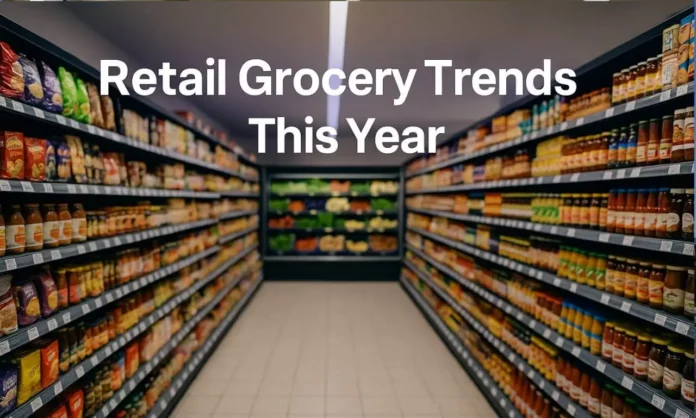The global grocery sector is under serious pressure. From inflation to automation, from consumer health shifts to climate-driven regulation, supermarkets are transforming faster than ever before. What was once a predictable industry has become a fast-moving, digitally charged, margin-sensitive battlefield.
Retailers around the world are facing structural cost increases, labour shortages, new fulfilment challenges, and customer expectations that shift by region and demographic. In 2025, understanding retail grocery trends is not just about observing patterns — it’s about staying ahead of the curve through strategic precision.
This report explores the most defining retail grocery trends of the year and how they’re impacting every corner of the supermarket business.
Key retail grocery trends this year:
- Fresh food is still a main category
- Private label area continues to expand
- Omnichannel -integration becomes standard
- Format in the store develops for speed and engagement
- Health and welfare product distributors parts
- Individual price and marketing increase
- Stability will arrange target operations again
- Local Purchasing and Flexibility Drive Supply Chain Strategy
- Work efficiency and automation growth
- Economic pressure changes consumer behavior
- Technology investment speed
- Global format and expansion continue
- Fresh food is still anchor
Fresh Food Still Defines Grocery Leadership
Fresh food continues to anchor the grocery business. While digital sales and delivery services rise, the in-store journey often begins with fresh categories: fruits, vegetables, meat, dairy, and bakery. Fresh is not just about health or price. It shapes how people move through the store, how baskets form, and how retailers create engagement.
In 2025, the importance of freshness goes beyond stocking shelves. Supermarkets are investing in digital shelf-life tracking, predictive ordering tools, and hyper-local supply chains to reduce spoilage and increase turnover. Some chains have cut delivery times for perishables in half. Others have redesigned floorplans to front-load fresh, increase grab-and-go efficiency, and reduce waste through better shelf matching.
Fresh food is no longer a department — it is a traffic strategy and a profitability engine.
Private Label Goes Premium
Private label is no longer about price—it’s about identity. What started as low-cost alternatives to national brands has now evolved into sophisticated, brand-calibre products in snacks, wellness, frozen, baby, and even international food categories.
In 2025, retailers are using private labels to protect margins, experiment with innovation, and build customer loyalty. Premium store brands are growing faster than traditional brands in many markets. Retailers are now focusing on gourmet items, diet-specific products, and sustainability-linked packaging within their private-label ranges.
Some chains are launching full brand families under one umbrella. Others are using consumer data to develop targeted product lines that address regional flavor trends or dietary shifts. In nearly every format, private label is moving from follower to first-mover.
Omnichannel Becomes Operational Standard
Grocery is now fully omnichannel. There is no longer a clear line between digital and physical. Customers browse online and buy in-store. Or shop in-store and reorder from apps. The journey is fluid, and retailers must deliver a seamless experience regardless of where it starts.
In 2025, the fastest-growing retailers have fully integrated digital platforms: shared pricing, synced promotions, centralised inventory, and connected customer profiles. Scan-to-pay, self-checkout, curbside pickup, home delivery, and locker collection are no longer seen as extras—they are essential.
Tech stacks that cannot support real-time inventory updates and cross-channel fulfilment are being replaced. Even small and mid-size grocers are adopting plug-and-play platforms that handle loyalty, delivery, product discovery, and store pick all in one system.
Store Formats Shift for Purpose, Not Size
The traditional supermarket layout is disappearing. In its place are stores designed around speed, mission, and engagement. Large stores are being downsized or reshaped. Smaller stores are doing more with less space. Chains are testing format by postcode, income bracket, and shopping pattern.
Some are eliminating full centre aisles in favour of high-rotation counters and quick-stop layouts. Others are creating hybrid zones—mixing café areas, click-and-collect points, or mobile-led checkout lanes. Self-service continues to expand, but it’s often met with shopper fatigue and error rates. Retailers are responding with staff-assist zones and smarter checkout AI.
In cities, micro-format stores are emerging: 5-minute shops designed for workday meals, refill items, or health-specific purchases. In suburbs, modular dark-store hubs are enabling faster fulfilment without added retail footprint.
No space is wasted. Every aisle is accountable.

Health Is a Non-Negotiable Filter
Shoppers are no longer looking for health-focused aisles—they expect wellness embedded in every category. This trend accelerated after 2020 and shows no sign of slowing. In 2025, food decisions are increasingly filtered through health logic: lower sugar, higher protein, clearer labels, and gut health benefits.
Even impulse items now carry health credentials. Functional drinks, vitamin-enhanced snacks, and plant-based hybrids are no longer niche—they are default selections in many markets. Shoppers also want transparency. Labels that are clean, easy to scan, and supported by visual shelf cues win.
For retailers, this means more than stocking wellness SKUs. It means planning assortments, store layouts, promotions, and even loyalty campaigns around health behaviour clusters. The grocers who treat health as core strategy — not seasonal promotion — are seeing stronger engagement and repeat purchase.
Pricing Moves to the Individual
Mass discounting is declining. Personalised pricing is on the rise. In 2025, loyalty apps, digital wallets, and mobile behaviour tracking allow retailers to tailor offers at scale. No longer are shoppers all given the same deal on Sunday. Instead, offers are based on past spend, location, time of day, and even cart behaviour.
Some chains are now dynamically adjusting promotions in real time—if a shopper skips meat twice in a row, a plant-based bundle appears. If a regular shopper skips a visit, their next coupon changes. It’s not just clever marketing. It’s strategic pricing designed to build frequency, basket, and retention.
Behind this are AI systems embedded in point-of-sale, app platforms, and inventory planning. The cost is high, but so is the return.
Sustainability Is Operational, Not Promotional
Environmental pressure has shifted from brand narrative to compliance and cost. In 2025, the carbon footprint of each item, package, and process is being measured, benchmarked, and monitored.
Grocers are investing in tools that track waste at SKU level, manage markdowns in real time, and optimise packaging per item and trip. Energy upgrades are being prioritised across stores and warehouses. Solar, refrigeration upgrades, and emission tracking are becoming part of cost-saving, not greenwashing.
Supply chains are under pressure to demonstrate transparency—not just on ethical sourcing, but on transport emissions, shelf life, and circular material usage. Sustainability is no longer a marketing choice. It is a business survival metric.
Supply Chains Go Local and Agile
The global grocery sector has rediscovered the value of local. In 2025, more perishable categories are sourced regionally—not only for freshness, but for flexibility and risk reduction.
Lead times have been cut. Forecasting systems are being rebuilt around hyper-local demand signals. Retailers are forming shorter contracts, more agile safety stock models, and regional distribution nodes to avoid bottlenecks.
Local does not mean small. Large chains are partnering with mid-size processors, urban farms, and vertical growing systems to balance scale with agility. This is not about nationalism—it’s about shelf availability and supply chain survival.
Labour Shortage Drives Smart Automation
Supermarkets across the globe are struggling to fill roles. Labour costs are up, but availability is down. In response, 2025 has seen rapid adoption of smart automation — not full robotisation, but intelligent assistive tech.
Digital shelf labels, predictive restocking alerts, electronic picking carts, AI queue monitoring, and staff-scheduling tools are all being deployed to boost productivity. Self-checkout stations are being retrofitted with camera validation and voice assistance to cut theft and error.
The most successful retailers are not removing humans. They are using technology to maximise the impact of limited staff. Task assignment, customer assistance, and loss prevention are all now part of a single, connected system.
Shopper Habits Have Permanently Shifted
Inflation, delivery norms, and lifestyle changes have reshaped how people shop for food. Full baskets are rarer. Shoppers make more frequent, shorter trips. They plan for immediate need, not weekly stock-up.
Loyalty is thinner. Shoppers are brand-flexible, mission-focused, and value-sensitive. Retailers report more mid-week visits, fewer impulse buys, and lower tolerance for empty shelves or broken digital experiences.
Every visit must now deliver real value — whether through convenience, health, freshness, or savings. The grocers that waste shopper time or fail on basics lose repeat business quickly.
Technology Investment Holds Despite Pressure
Despite margin strain, grocery tech investment continues in 2025. The focus is on infrastructure that supports margin and agility: dynamic pricing, digital twins, computer vision, inventory bots, and AI-driven planning platforms.
Some chains have built virtual stores for real-time demand simulation. Others use AI to optimise planograms and avoid out-of-stock. Fulfilment centres are increasingly run by systems that learn and adjust from order flow hourly, not quarterly.
Tech is no longer experimental. It’s mission-critical.
Formats Adapt by Region
Globally, store formats are no longer uniform. In urban Asia, scan-only kiosks and mobile-led hubs dominate. In the U.S., full-service stores anchor real estate portfolios. In Europe, hybrid convenience-plus-fresh formats are rising. In Africa and the Middle East, digital-first chains are skipping legacy infrastructure altogether.
What unites them all is speed and data. Whether a 20,000 square foot hypermarket or a 200 square foot express shop, the successful format in 2025 is the one most responsive to local demand, digital engagement, and operational cost.
Conclusion
Retail grocery trends in 2025 reflect a sector that is no longer stable and slow-moving. Every part of grocery — from supply chain to shelf, from pricing to store format — is under transformation. The shifts are not temporary. They are structural.
Winners in this space are not just those who adopt technology or launch digital campaigns. They are the grocers who integrate data, simplify formats, reduce waste, personalise pricing, and meet shoppers where they are — both physically and behaviourally.
Fresh food leads traffic. Private label grows profit. Health filters everything. Local builds flexibility. Automation fills the gaps. And technology ties it all together.
These are the retail grocery trends defining 2025. The job now is not to watch the wave — it’s to ride it.



